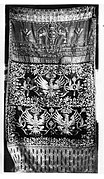Przedbórz Synagogue
| Przedbórz Synagogue | |
|---|---|
 Wooden synagogue of Przedborz in 1909 | |
| Religion | |
| Affiliation | Judaism |
| Ecclesiastical or organizational status | Destroyed |
| Location | |
| Location | Przedbórz, Poland |
| Geographic coordinates | 52°05′14″N 19°52′20″E / 52.0872°N 19.8722°E |
| Architecture | |
| Style | Wooden |
| Completed | 1760 |
| Destroyed | 1939 |
The Przedbórz Synagogue was a wooden synagogue in Przedbórz, Poland.
History
A Jewish community is documented to have been established in Przedbórz by 1570.[1] At the beginning of World War II, the town was 60% Jewish.[2]
The building was erected after the previous synagogue burnt down in 1754, but completed by 1760, the date given on a wall painting.[3]
It was destroyed in 1939.[1]
Architecture
The synagogue of Przedbórz, regarded as one of Poland's "most beautiful" wooden synagogues,[4] once drew tourists to the small town.[2]
The synagogue, built on a stone foundation, featured a main hall 14.20 meters long with a women's balcony above a large vestibule or side hall. The barrel vaulted main hall rose to a height of 8.80 meters. The wooden, barrel vaulted ceiling was paneled in wood in an intricate lunette and star motif that gave something of the impression of an intricate, curved lattice work. An elaborate, octagonal, Baroque Bimah rose in three tiers almost to the ceiling, but ended in a decorative finial topped by an eagle with wings outspread, and did not touch or support the roof. The Baroque Torah Ark was elaborately carved with lions rampant, floral decorations, and animals.[5]
The walls were elaborately painted with a menorah, an illustration of Psalm 137 featuring trees beside the river of Babylon with musical instruments hanging form the branches, landscapes of towns, the texts of prayers surrounded by garlands of leaves and flowers, and other motifs. High on the north wall a painted legend read, "This is the work of Yehuda Leb's own hands, 1760."[5]
Reconstruction project
In 2002, Congregation Beth Israel of Berkeley, California, in need of a new building, began a campaign to construct a replica of the Przedbórz Synagogue.[2] The project had to be abandoned when fundraising fell short.[6]
Gallery
-
North side
-
Synagogue as seen from the river Pilica
-
Synagogue as seen from the river Pilica
-
Entrance doors
-
Tzedakah box near the entrance door
-
The Torah Ark
-
Torah Ark curtain - parochet
-
A portion of the wall and ceiling
-
A portion of the painted ceiling
-
Torah shields
-
Torah crown and Torah shields
-
Ceiling
-
Bimah
References
- ^ a b Maria and Kazimierz Piechotka, Heaven's Gate: Wooden Synagogues in the Territory of the Former Polish-Lithuanian Commonwealth, Institute of Art, Polish Academy of Sciences, Wydawnnictwo Krupski I S-ka, Warsaw, 2004, p. 328 ISBN 978-8386117536
- ^ a b c Margie Mason (January 26, 2002), "Berkeley Congregation Plans to Re-Create 17th Century Temple" Los Angeles Times.
- ^ Maria and Kazimierz Piechotka, Heaven's Gate: Wooden Synagogues in the Territory of the Former Polish-Lithuanian Commonwealth, Institute of Art, Polish Academy of Sciences, Wydawnnictwo Krupski I S-ka, Warsaw, 2004, p. 322 ISBN 978-8386117536
- ^ Encyclopedia of Jewish Life Before and During the Holocaust, Shmuel Spector, editor, New York University Press, 2001 vol. II, p. 1032 ISBN 978-0814793770
- ^ a b Maria and Kazimierz Piechotka, Heaven's Gate: Wooden Synagogues in the Territory of the Former Polish-Lithuanian Commonwealth, Institute of Art, Polish Academy of Sciences, Wydawnnictwo Krupski I S-ka, Warsaw, 2004, pp. 322-8 ISBN 978-8386117536
- ^ June Bell (March 21, 2003) "Wooden Synagogue Project Abandoned", The Forward















